Christmas is a time of tradition. Whether we like it or not, we tend to spend each year doing, eating, and drinking the same as we did the year before. Whilst everybody’s idea of Christmas will be personal, usually based on childhood memories, there are clearly a shared set of rituals that most of tend to follow: mince pies, turkey or goose, crackers, Christmas pudding. There are also certain styles of wine that we associate with Christmas (though these associations are probably not based on childhood memories!). We decided to look a bit further into the online popularity of specific regions and styles of wine to determine whether in fact we do all drink the same things over the festive season.
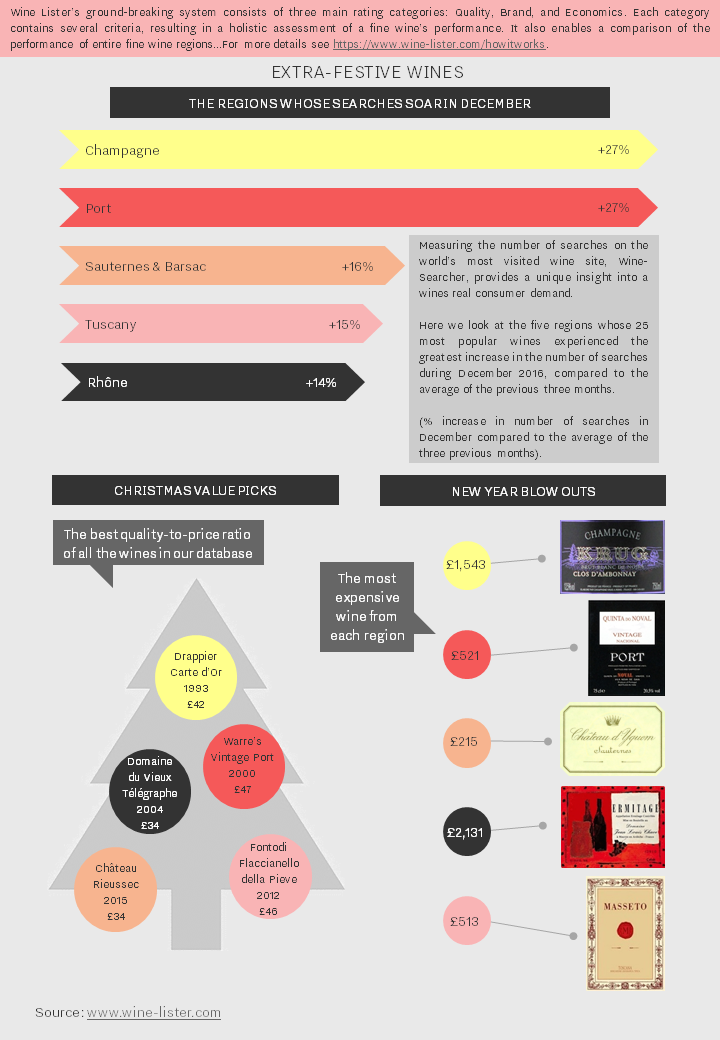
Comparing the search frequency of each region’s 25 most popular wines on Wine-Searcher during December 2016 compared to the average of the previous three months, the results are conclusive. Champagne and Port both enjoyed a dramatic surge in popularity – receiving over a quarter more searches during December. Whilst Port’s dramatic increase in online search frequency was presumably because it is the classic accompaniment to another festive favourite – Stilton – Champagne’s seasonal rise in popularity must be because it is not just the tipple of choice at Christmas parties, but also at New Year’s celebrations.
It seems that we also tend to favour the sweet whites of Sauternes and Barsac over Christmas, their 25 most popular wines enjoying a 16% increase in online search frequency. When it comes to dry reds, we appear to gravitate towards hearty styles at this time of year, with Tuscany and the Rhône also experiencing noticeable boosts in online popularity (up 15% and 14% respectively).
If you haven’t yet stocked up on those perennial favourites, Wine Lister’s Value Pick search tool can help you effortlessly find top Quality at a reasonable price. Each of our Christmas Value Picks achieves an outstanding Quality score of at least 965, putting them amongst the very best on Wine Lister. With the most expensive – Warre’s Vintage Port 2000 – available for as little as £47, they represent remarkable value.
If you are after a really special bottle for New Year’s, then we also show the most expensive wine from each region. Each of these wines qualify as Wine Lister Buzz Brands, and is sure to help start 2018 with a bang.
Download a PDF version here.
First published in French in En Magnum.
Wines featured: Drappier Carte d’Or 1993; Domaine du Vieux Télégraphe Châteauneuf-du-Pape 2004; Rieussec 2015; Fontodi Flaccianello della Pieve 2012; Krug Clos d’Ambonnay; Quinta do Noval Porto Nacional Vintage Port; Château d’Yquem; Jean-Louis Chave Hermitage Cuvée Cathelin; Masseto
Bodegas Vega-Sicilia has today released a host of wines. Alongside the 2018 edition of Unico Reserva Especial (£240 per bottle / £720 per case of three) and Valbuena 2013 (£78 per bottle / £234 per case of three), comes Unico 2006 at £195 per bottle / £585 per case of three. Below we look at all the facts about Spain’s top wine.
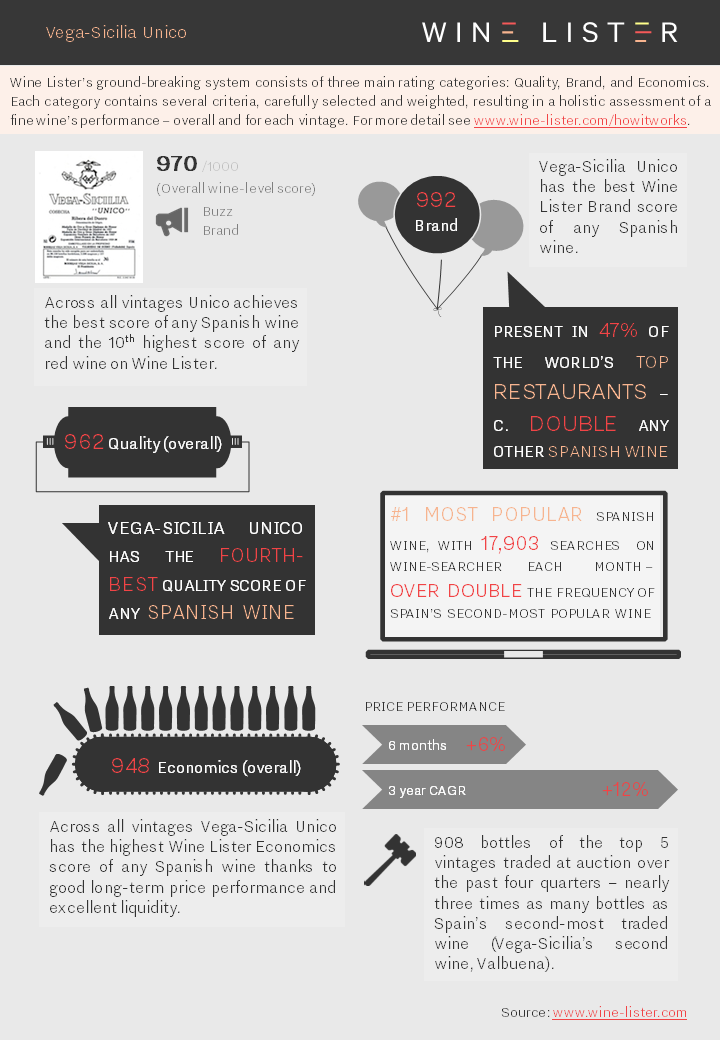
You can download the slide here: Wine Liser Fact Sheet Vega-Sicilia Unico
This week’s top five takes Wine Lister to the Douro Valley in search of its vintage ports. In some ways this top five is very much a four plus one, with the fifth placed Quinta do Noval Nacional, costing nine to ten times more than each of the others. It is also the only one to enjoy Buzz Brand status. At a total Wine Lister score of 880 and £521 per bottle, against the top-ranked Taylor’s 932 and £60, that constitutes quite a buzz.
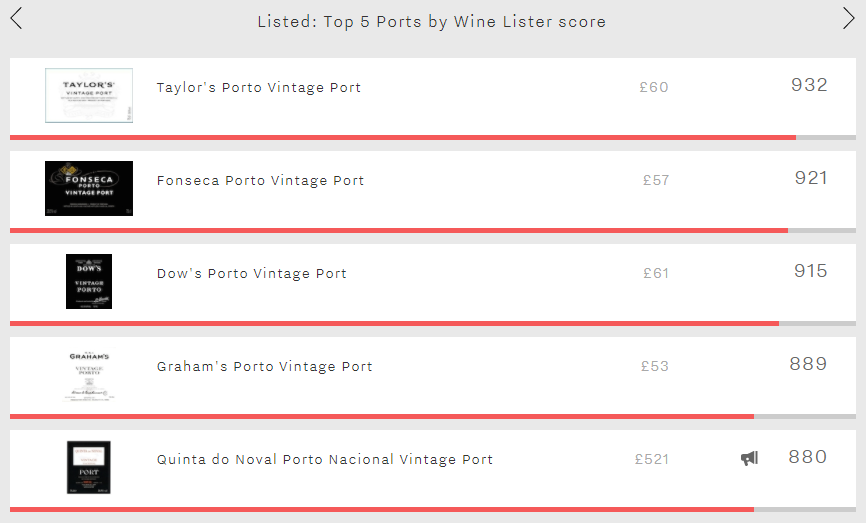
Here is a classic case of all metrics count but some count for more than others when it comes to cost. With a stonking 981 for Quality and the longest drinking window in its peer group the Quinto do Noval is clearly the nichest of the niche; its relatively low restaurant presence (9%) and monthly searches (2,457, on average, to Taylor’s 10,787) make its Wine Lister Brand score (825) well below Taylor’s and the other three.
With an overall score of 932, an excellent Quality score of 967, and a Brand score of 965 based on decent restaurant presence (23%) and over 10,700 average monthly searches, Taylor’s tops the Vintage ports. Fonseca comes a close second at an overall 921. With almost identical Quality (965) and slightly lower Brand (942), Fonseca just pips Taylor’s for liquidity, with 1,072 (against 1,061) of its top five vintages traded at auction in the past year.
At around £60 per bottle on average, Taylor’s and Fonseca are each affordable flutters with future Christmases in mind. Even illustrious older vintages such as 1970 and 1977 – in their drinking prime this Christmas – can be found at two to three times the price.
The same goes for third-placed Dow’s (£61) and fourth-placed Graham’s (£53). At an overall 915 Dow’s has a slightly lower Quality score than the top two. 943 is nevertheless still highly creditable. Graham’s edges Dow’s on Quality at 948 but a relatively lowly 650 for Economics brings it down to 889 overall.
All in all, Taylor’s and Fonseca merit their top two spots. If Santa has very deep pockets then consider adding Quinto do Noval 1994 to your wishlist (at a cool £1,229).
Brands such as Sassicaia or Masseto are virtually household names. Known to most as ‘Super Tuscans’, the unofficial ‘Crus Classés’ of Tuscany’s IGT-elite have garnered a reputation for high quality and investment calibre over the last 20 years, and have a price tag to match.
Most would agree that the first Super Tuscan was Sassicaia, produced by Mario Incisa della Rocchetta, who planted Cabernet Sauvignon for his family’s own personal stock, before releasing it commercially from 1968.
The early Super Tuscan sought to by-pass the DOC system and rules banning international varieties. Labelled simply as ‘vino da tavola’, consumers were able to decide for themselves on the quality of the liquid in the bottle. Meanwhile, Sassicaia earnt its own DOCG in 2013, and has the strongest brand in Italy and one of the strongest in the world – but what of the rest?
Last month Wine Lister explored Italy’s top wines for Economics, and found that the economic profiles of Piedmont’s top wines (Barolo and Barbaresco), beat their Tuscan counterparts. So what can consumers expect from Tuscany, apart from an idyllic holiday destination?
The Tuscan crown for Brand scores still firmly sits on the heads of the big five (Sassicaia, Tignanello, Ornellaia, Masseto, and Solaia), but with a little more digging, exceptional quality can certainly be found beyond these few names. Indeed, eight of Wine Lister’s top 10 Italian Value Picks by Quality score come from the country’s central region:
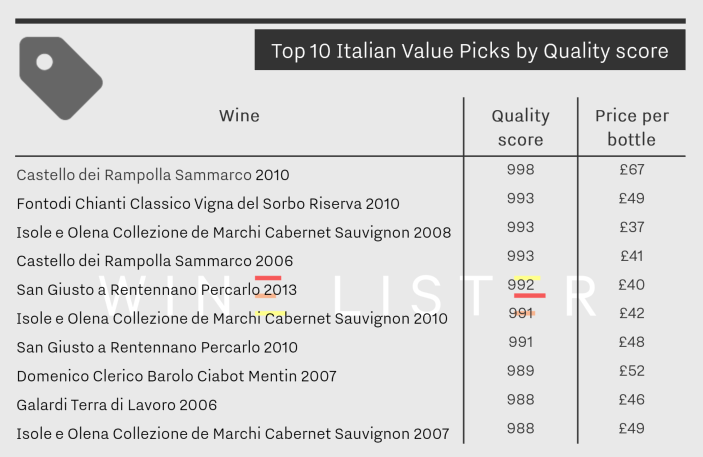
Value Picks are defined as wines with the best quality-to-price ratio, with an emphasis on quality. Of the Tuscan entries, only one is a DOCG – the Chianti Classico Vigna del Sorbo Riserva 2010 from Fontodi. The others are IGT, or ‘Super Tuscan’, such as Castello dei Rampolla Sammarco 2006 and 2010, and San Giusto a Rentannano Percarlo 2010 and 2013.
On average, Super Tuscan Value Picks cost £26 per bottle, and achieve Quality scores of 864. Meanwhile Super Tuscan Buzz Brands cost six times as much for the for an average Quality score of 889.
Whether Tuscany’s classification system will be able to define a true quality hierarchy in time is not clear. In the meantime, Wine Lister’s scoring system sheds some light on where the real value of Tuscany lies.
Also featured: Isole e Olena Collezione de Marchi Cabernet Sauvignon; Domenico Clerico Barolo Ciabot Mentin; Galardi Terra di Lavoro
As the temperature drops, the natural reaction can be to reach for structured reds and hearty meals. The great Chardonnays of Corton-Charlemagne also warm the cockles, and belong in pride of place on any Christmas table. Here we look at the appellation’s top five brands.
Wine Lister’s Brand score measures a wine’s prestige – as indicated by its visibility in the world’s top restaurants – and popularity – as shown by the number of searches it receives each month on Wine-Searcher. Corton-Charlemagne’s top brand is Bonneau du Martray’s offering (947). This outstanding Brand score is the result of achieving by far the greatest level of restaurant presence of the group – it is visible in nearly twice as many of the world’s top establishments as the next-best of the five (Coche-Dury’s Corton-Charlemagne) – coupled with being comfortably the most popular of the group, receiving 24% more searches each month than the runner-up. No wonder it is one of the group’s three Buzz Brands.
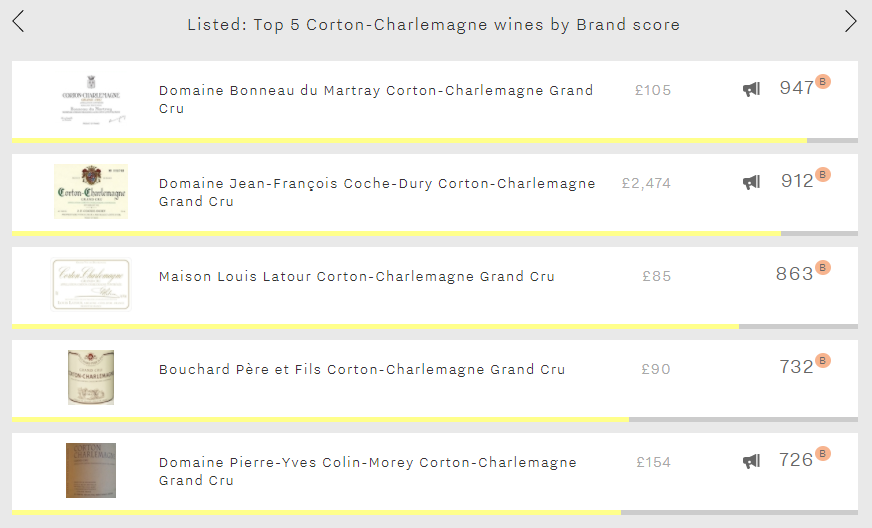
In second place is Coche-Dury’s offering with a score of 912 for Brand, in fact its weakest category – perhaps unsurprising given its formidable Economics and Quality scores (985 – the highest of any white Burgundy – and 969 respectively). Its economic might is the result of its extraordinary price (£2,474), which is over 15 times higher than the second-most expensive wine of the group (the Pierre-Yves Colin-Morey (£154).
Almost 50 points further behind is Maison Louis Latour’s Corton Charlemagne (863). Unlike the Coche-Dury, its Brand score is its best facet. This is thanks to very strong performance across both brand criteria – it features in 13% of top restaurants and receives 2,500 searches each month on average.
Trailing over 130 points further behind, Corton-Charlemagne’s next-strongest brands are separated by just six points – Bouchard Père et Fils (732) and Pierre-Yves Colin-Morey (726). Whilst strong, their Brand scores are no match for their excellent quality scores (917 and 950 respectively). In fact, it seems that quality doesn’t play an obvious role in establishing brand strength within Corton-Charlemagne:
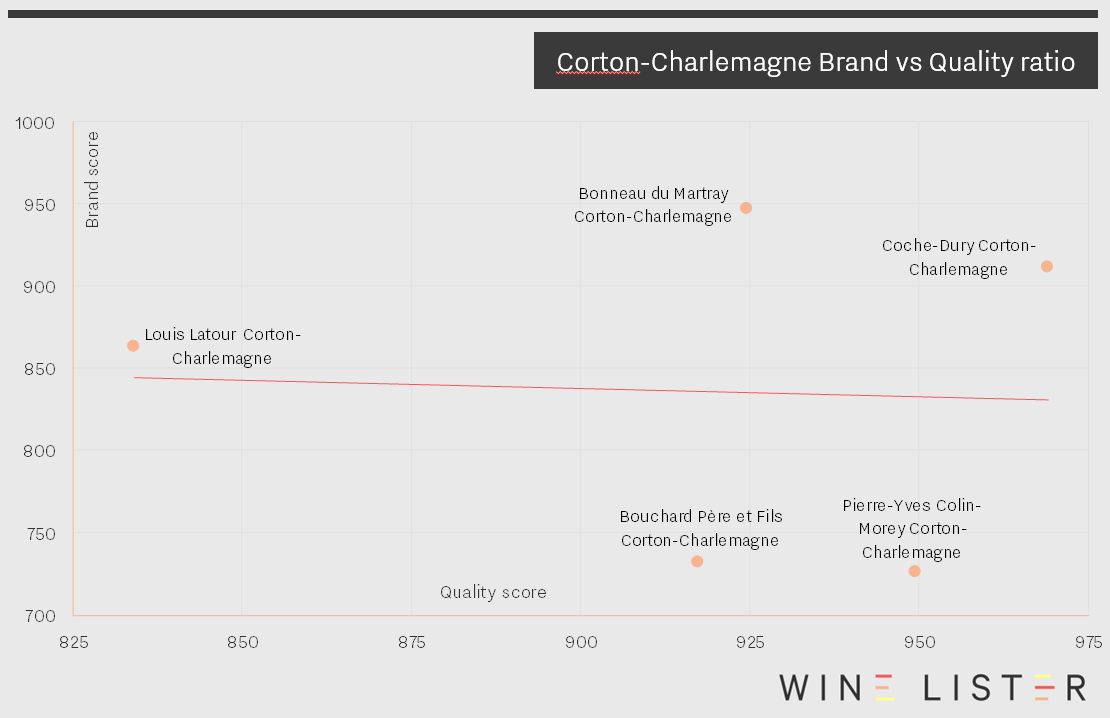
Whilst Corton-Charlemagnes’s top five Brands display no correlation between quality and brand recognition, as indicated by the flat trendline, quality is much more of a factor for the top brands of another of Burgundy’s most prestigious appellations, Montrachet:
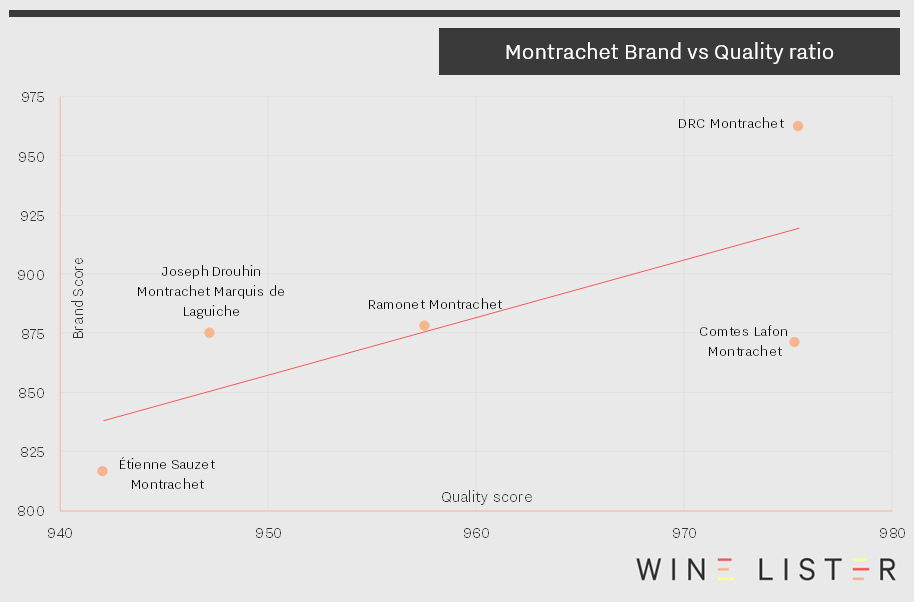
Remember that even if you don’t currently have a Wine Lister subscription you can access all the underlying data behind these five wines as well as those featured in other recent Top 5s, giving you an insight into the wealth of tools at our subscribers’ disposal.
As we edge ever closer to Christmas, it feels appropriate to take a look at sweet wines. Here we consider Alsace’s top 5 sweet whites by overall Wine Lister score. Produced in a thin sliver of land in the far East of France, Alsace’s top sweet whites are separated by just nine points (less than one hundredth of Wine Lister’s 1,000-point scale!). The five wines display very similar profiles, all outperforming in the Quality category, achieiving middling Brand scores, and trailing economically.
Four break the 900-point boundary in terms of Quality scores, putting them amongst the very top quality wines on Wine Lister. Hugel et Fils Riesling Vendange Tardive (VT) falls just short with 881 points, still a very strong Quality score (thanks to 17/20 from both Jancis Robinson and Bettane+Desseauve, and 92.5/100 from Vinous). The same producer’s Gewürtzraminer VT scores even higher for quality (910) thanks to a 95/100 from Jeannie Cho Lee:
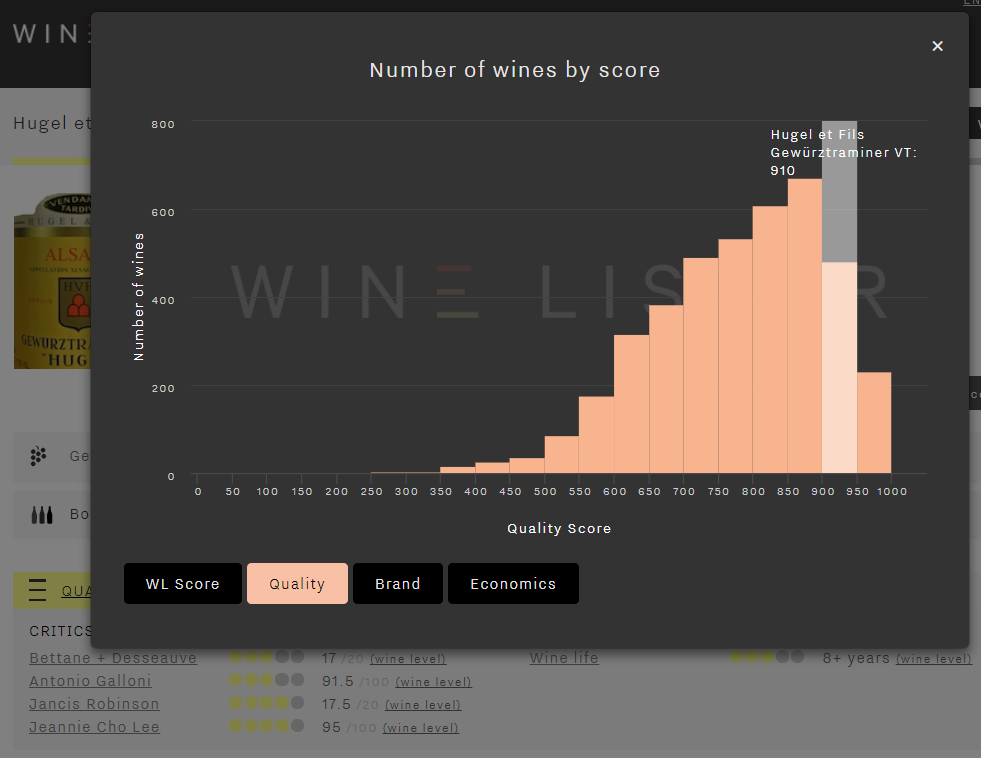
Moving categories, scores drop sharply from an average Quality score of 915 to 550 for Brand – still above the average for all wines on Wine Lister:
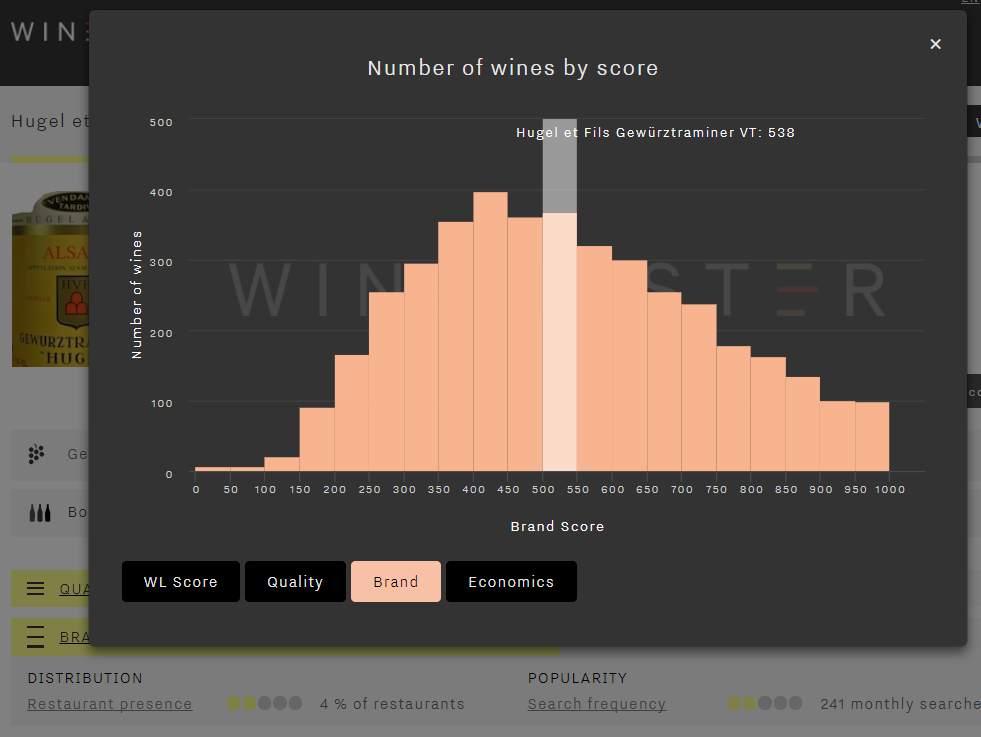
Economics scores trail even further behind, averaging 338, hindered by low liquidity. For example, Hugel’s Gewürtzraminer VT failed to trade a single bottle at auction over the past four quarters (as measured by Wine Market Journal). The chart below shows Economics score in the context of all the wines on Wine Lister – its is well below the average, with a score below 400 putting in the “weak” score band:
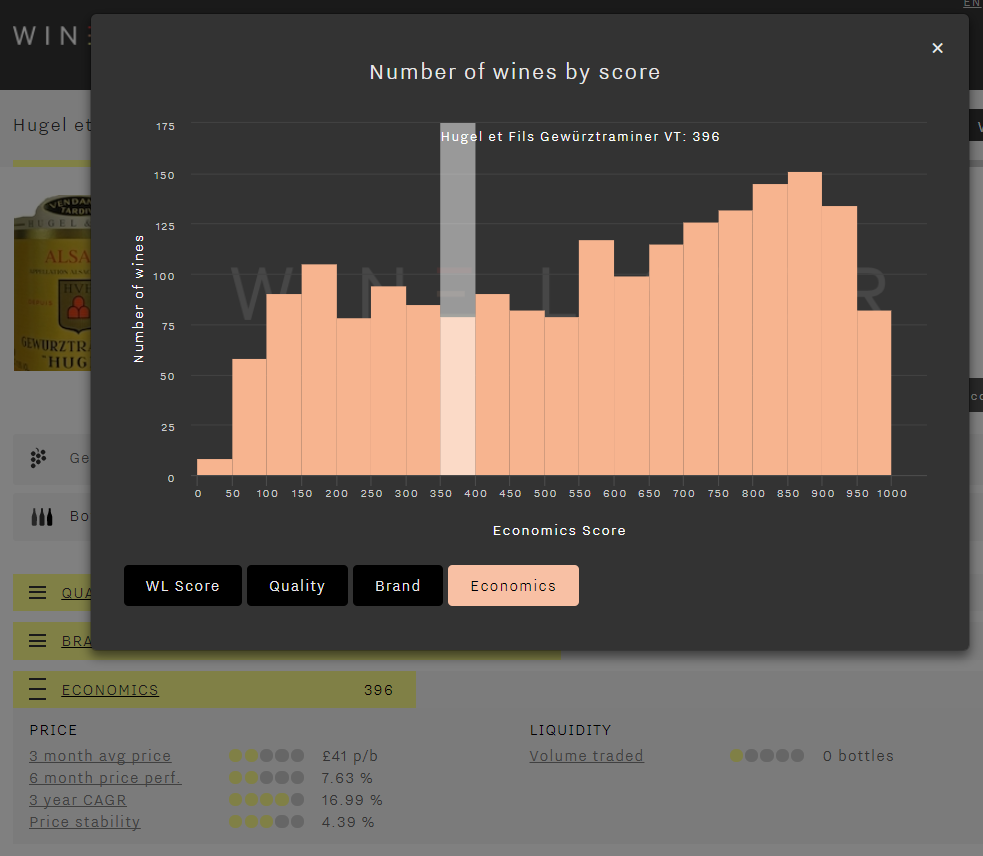
Other wines making the top five are Zind-Humbrecht Jebsal Pinot Gris VT (675) and Trimbach Gewürztraminer VT, which achieves the best restaurant presence of the group. However, featuring on just 6% of the world’s best restaurant lists, this suggests that Alsace’s sweet whites are not every sommelier’s must-list bracket, even when produced by the region’s most famous producer. Incidentally, Trimbach’s Clos Sainte Hune appears in 34% of wine lists (compared to 69% for Sauternes’ Château d’Yquem).
The last wine making it into this week’s Listed section is Marcel Deiss Altenberg de Bergheim Grand Cru. The only non-single varietal wine of the group, it is a blend of 13 different varietals planted in the same plot, and is by far Bettane+Desseauve’s preferred wine of the group – the French duo award it an average score of 19/20. It is also the most popular wine of the group. However, its modest average search frequency (380 per month on Wine-Searcher) confirms that Alsace’s sweet whites currently fly well under the radar.
So, when you’re stocking up your cellar for Christmas, give Alsace’s sweet whites a go. They might not be the most prestigious, but the quality is there and prices are pleasing.
Confirming the outstanding economic performance of Piedmont’s top crus, Italy’s top five wines for economics all hail from Barolo and Barbaresco. Tuscany doesn’t get a look-in. Featuring just two producers – Giacomo Conterno and Bruno Giacosa – this week’s listed section boasts wines achieving outstanding Economics scores of over 960.
Wine Lister’s Economics score combines five criteria: three-month average price, six-month-price performance, three-year compound average growth rate (CAGR), price stability, and liquidity (volume traded).
A three-month average price of £595 per bottle tips the Economics rating in favour of Giacomo Conterno’s Barolo Monfortino Riserva, which scores a mighty 978. Its three-month average price is over double that of the second-most expensive wine.
Seven points behind in second place is the Barbaresco Asili Riserva from Giacosa’s Azienda Agricola Falletto, with an Economics score of 971. Just one point behind that, in third place, with an Economics score of 970, Giacomo Conterno’s second wine to make the top five is the Barolo (Cascina) Francia. Following a slump in its score at the end of 2016, it bounced back January and continued to rise throughout the year.
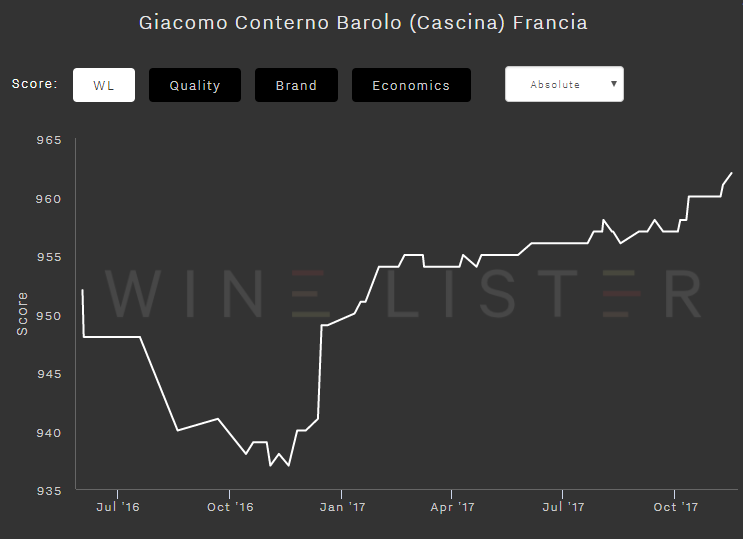
Giacosa’s Azienda Agricola Falletto Barbaresco Rabajà is fourth-highest with a score of 963. This wine has the strongest three-year CAGR of the group, at 27.5%.
Bruno Giacosa’s third entry, completing the top five with an Economics score of 963, is his Barolo Rocche Falletto Riserva. It has the highest liquidity of the group, with 500 bottles of its top five vintages traded in the past year.
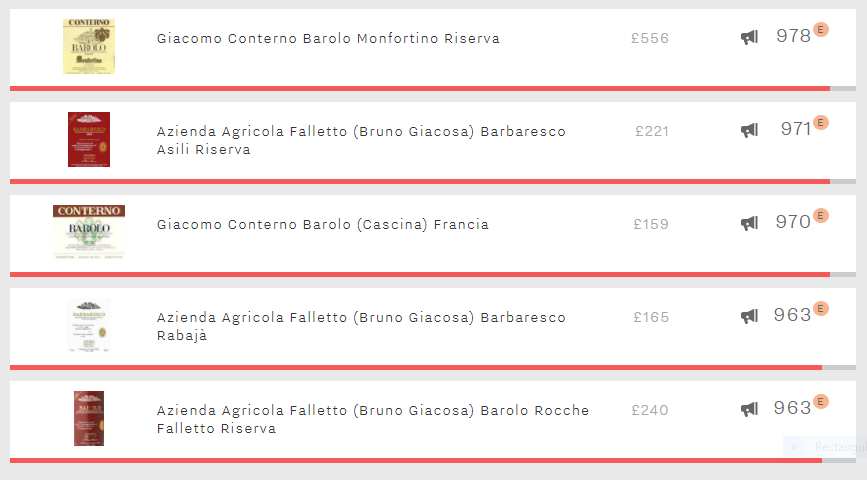
All of the top five hold Buzz Brand status, but their soaring prices equate to lower price stability across the group, averaging 8.6% standard deviation compared to 7.1% for the top five Tuscan wines by Economics score. Piedmont might offer more potential upside, but by definition this makes it riskier investment territory.
We recently prepared a brief vintage overview for the Institute of Masters of Wine’s 2013 Claret tasting. Analysing the performance of the basket of wines included in the tasting, Wine Lister’s holistic and dynamic approach allows us to not only see which appellations produced the vintage’s best wines, but also demonstrates if and how the market has since reacted to each appellation’s relative quality.
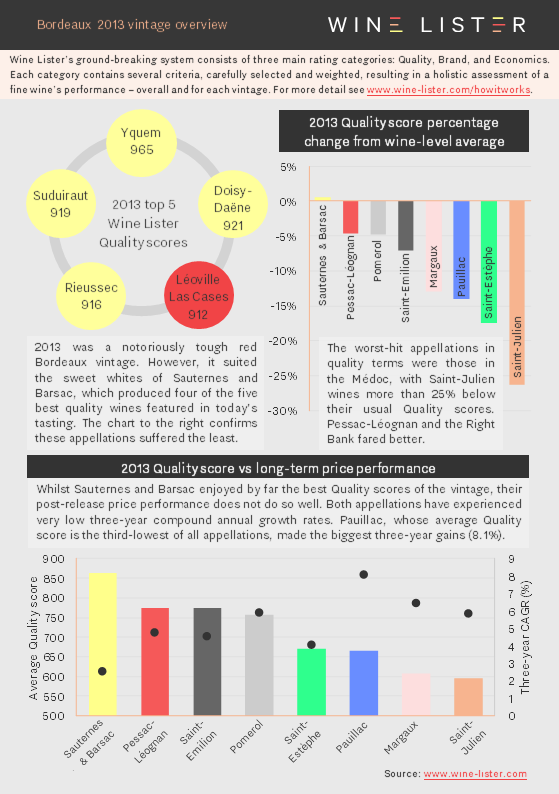
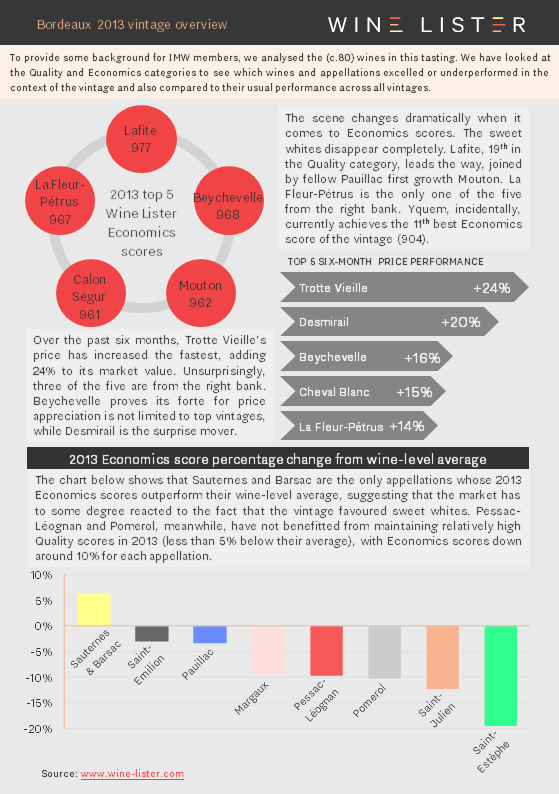
You can download these slides here: Wine Lister Bordeaux 2013 vintage overview
Watch this space for further regional vintage reports over the coming months.
This week, our listed section journeys to the most northerly Burgundy appellation to look at Wine Lister’s top five Chablis by Quality score. Wine Lister’s Quality score comprises the average rating of our four partner critics, as well as a wine’s ageing potential.
In fifth place is Hidden Gem, Domaine Gérard Duplessis Chablis Grand Cru Les Clos. Producing only 1,500 bottles a year, this wine is present in just 2% of the world’s top restaurants, but receives a very strong rating from Jancis Robinson, setting its Quality score at 910.
Domaine William Fèvre Chablis Grand Cru Les Clos is fourth-highest with a Quality score of 927. Whilst Jeannie Cho Lee doesn’t score the wine as highly as our other critics, at £55 it still represents a lot of bang for your buck.
Bronze goes to Domaine Raveneau Chablis Grand Cru Valmur, with a Quality score of 946. The only wine of the group not from the Les Clos climat, it has a predicted drinking window of 10 years – higher than the rest of its peer group, which averages eight years.
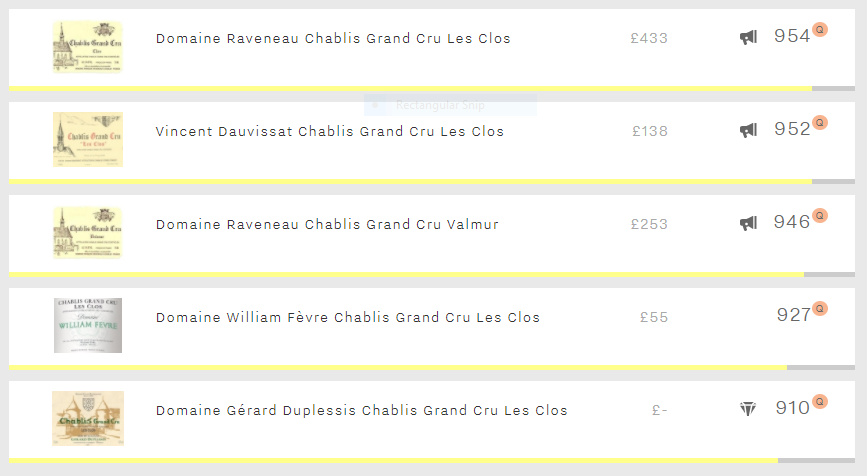
Vincent Dauvissat Chablis Grand Cru Les Clos has the second-highest Quality score (952) and also has the biggest variance in ratings from our partner critics, receiving an outstanding score from Jeannie Cho Lee, but a far more modest one from UK critic Jancis Robinson.
Winning the Quality score crown by a narrow two-point difference (954) is the second wine of the group from Raveneau – the domaine’s Les Clos offering. Enjoying uniformly excellent scores from each of our partner critics, it’s one of the most talked-about wines in the fine wine trade and unsurprisingly holds Wine Lister Buzz Brand status.
The latest three-month average search frequency data is in, and with it we can see which wines’ increase in popularity has boosted their Brand score. Here we focus on the five wines that saw the largest increase. All saw at least a 29-point rise in their Brand score.
Château Montviel saw the greatest increase, gaining 60 Brand points and taking its overall Wine Lister score to 523. Its average monthly search frequency of 1,085 remains its strongest criterion score, as its three-month average price (£31) and liquidity hold it back — it has failed to trade a single bottle at auction over the past year.
The second-highest increase was Campo Eliseo, whose Brand score rose 37 points to 453. Although it holds the lowest overall Wine Lister score of the group (490), it had the greatest surge in online surge frequency (+64%).
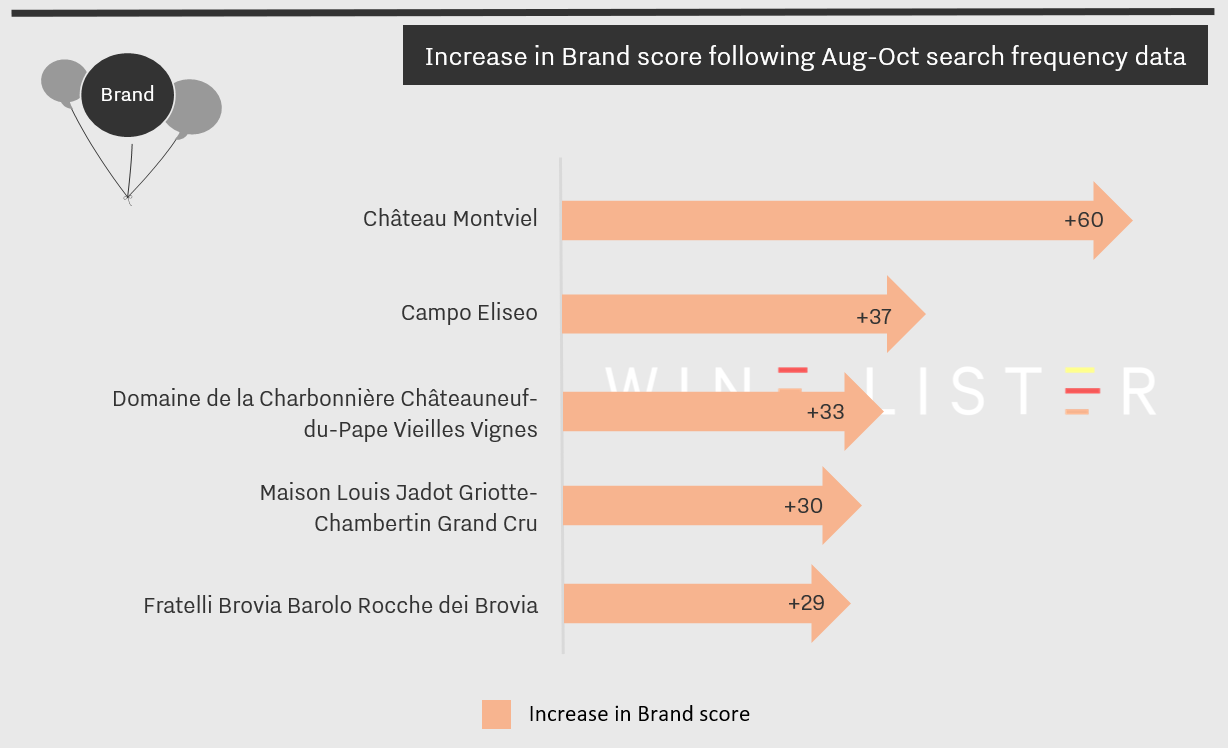
Following a drop in its price over the last six months, Domaine de la Charbonnière Châteauneuf-du-Pape Vieilles Vignes also saw a welcome increase in search frequency (+51%) and a subsequent Brand score increase of 33 points to 437, pushing its overall score towards the ‘Strong’ band on the overall Wine Lister scale (now just 17 points short at 583).
The fourth-highest increase, though still the with the lowest overall search frequency of the five (172 searches), is Maison Louis Jadot Griotte-Chambertin Grand Cru. Currently holding Hidden Gem status, is this an early sign that this wine won’t be under the radar for much longer?
Finally, Fratelli Brovia Barolo Rocche dei Brovia saw an increase of 29 Brand points to 654, following a 45% increase in search frequency. US partner critic Antonio Galloni rates it very highly, with the result that it achieves the highest overall Wine Lister score of the group (702).
So, with an impressive 10% increase in its Brand score this month, Château Montviel is the one to watch as we move in to the winter months.















